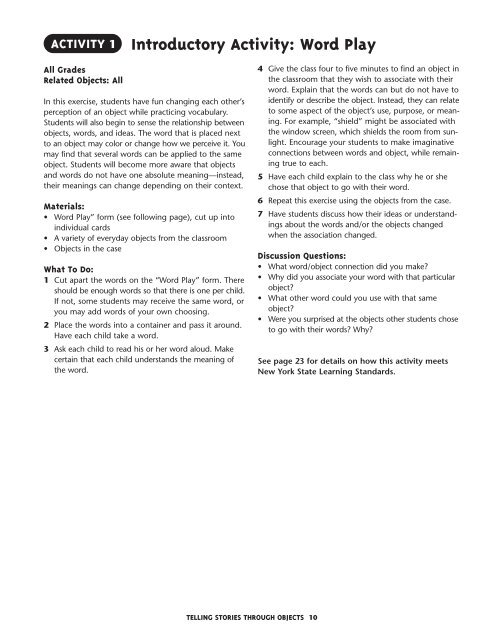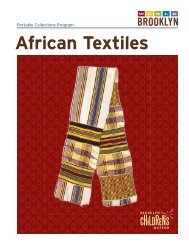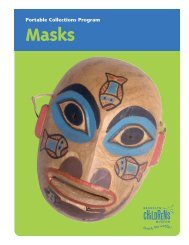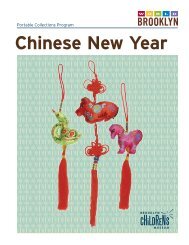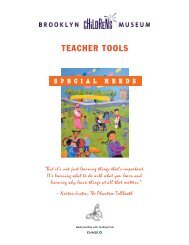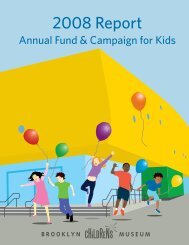Telling Stories Through Objects - Brooklyn Children's Museum
Telling Stories Through Objects - Brooklyn Children's Museum
Telling Stories Through Objects - Brooklyn Children's Museum
You also want an ePaper? Increase the reach of your titles
YUMPU automatically turns print PDFs into web optimized ePapers that Google loves.
ACTIVITY 1<br />
All Grades<br />
Related <strong>Objects</strong>: All<br />
Introductory Activity: Word Play<br />
In this exercise, students have fun changing each other’s<br />
perception of an object while practicing vocabulary.<br />
Students will also begin to sense the relationship between<br />
objects, words, and ideas. The word that is placed next<br />
to an object may color or change how we perceive it. You<br />
may find that several words can be applied to the same<br />
object. Students will become more aware that objects<br />
and words do not have one absolute meaning—instead,<br />
their meanings can change depending on their context.<br />
Materials:<br />
• Word Play” form (see following page), cut up into<br />
individual cards<br />
• A variety of everyday objects from the classroom<br />
• <strong>Objects</strong> in the case<br />
What To Do:<br />
1 Cut apart the words on the “Word Play” form. There<br />
should be enough words so that there is one per child.<br />
If not, some students may receive the same word, or<br />
you may add words of your own choosing.<br />
2 Place the words into a container and pass it around.<br />
Have each child take a word.<br />
3 Ask each child to read his or her word aloud. Make<br />
certain that each child understands the meaning of<br />
the word.<br />
TELLING STORIES THROUGH OBJECTS 10<br />
4 Give the class four to five minutes to find an object in<br />
the classroom that they wish to associate with their<br />
word. Explain that the words can but do not have to<br />
identify or describe the object. Instead, they can relate<br />
to some aspect of the object’s use, purpose, or meaning.<br />
For example, “shield” might be associated with<br />
the window screen, which shields the room from sunlight.<br />
Encourage your students to make imaginative<br />
connections between words and object, while remaining<br />
true to each.<br />
5 Have each child explain to the class why he or she<br />
chose that object to go with their word.<br />
6 Repeat this exercise using the objects from the case.<br />
7 Have students discuss how their ideas or understandings<br />
about the words and/or the objects changed<br />
when the association changed.<br />
Discussion Questions:<br />
• What word/object connection did you make?<br />
• Why did you associate your word with that particular<br />
object?<br />
• What other word could you use with that same<br />
object?<br />
• Were you surprised at the objects other students chose<br />
to go with their words? Why?<br />
See page 23 for details on how this activity meets<br />
New York State Learning Standards.


